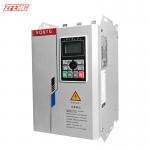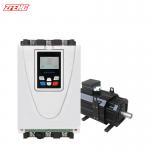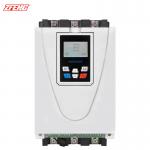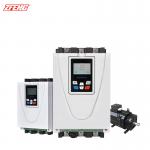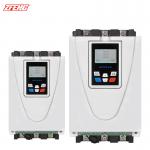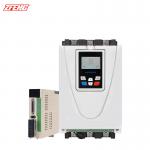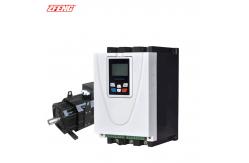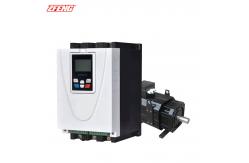ZF-R Series Heavy-Duty Motor Soft StarterA heavy-duty soft starter is a specialized motor control device designed for heavy-load
starting scenarios. It enables smooth and efficient starting of
heavy-load equipment by gradually adjusting voltage or current,
thereby avoiding the impact of traditional starting methods on
motors and power grids.
I. Features - High Starting Torque: Capable of providing sufficient starting torque to meet the
demands of heavy-load equipment.
- Current Limiting: Restricts starting current to prevent impact on the power grid
and motor.
- Multiple Starting Modes: Supports voltage ramp starting, current limiting starting, torque
control starting, and other modes to adapt to different load
characteristics.
- Protection Functions: Equipped with overload, overcurrent, phase loss, and overheating
protection to ensure safe operation of the equipment.
- Strong Adaptability: Suitable for various harsh operating conditions, such as high
temperatures, high humidity, and dusty environments.
II. Working Principle of Heavy-Duty Soft StartersVoltage Regulation
The heavy-duty soft starter controls the conduction angle of
thyristors (SCRs) to gradually increase the input voltage to the
motor, allowing the motor speed to rise smoothly from zero to the
rated speed. Current Limiting
During startup, the soft starter continuously monitors the motor
current. When the current exceeds the set value, it automatically
adjusts the output voltage to limit the current within a safe
range. Torque Control
By adjusting the relationship between voltage and frequency, the
soft starter can precisely control the motor's starting torque,
ensuring smooth startup of heavy-load equipment. Bypass Switching
Once the motor has started, the soft starter automatically switches
to a bypass contactor, which directly supplies power to the motor,
reducing energy consumption and heat generation of the soft
starter.
III. Application Scenarios of Heavy-Duty Soft StartersMining Machinery
Such as crushers, ball mills, and conveyors, which require high
starting torque. Heavy-duty soft starters can provide sufficient
starting torque while avoiding impact on the power grid. Petrochemical Industry
Such as compressors and pumps, which generate large inertial loads
during startup. Heavy-duty soft starters enable smooth startup and
reduce mechanical wear. Metallurgical Industry
Such as rolling mills and fans, which have high requirements for
starting torque and smoothness. Heavy-duty soft starters can meet
these startup needs. Power Industry
Such as large water pumps and fans, which can cause significant
impact on the power grid during startup. Heavy-duty soft starters
can limit starting current and protect grid safety.
IV. Advantages of Heavy-Duty Soft StartersMotor Protection
Smooth startup reduces mechanical and thermal stress on the motor,
extending its service life. Grid Protection
Limiting starting current prevents impact on the power grid,
reducing voltage fluctuations and power outage risks. Improved Equipment Reliability
Reducing mechanical shock during startup lowers equipment failure
rates and enhances production efficiency. Energy Savings
In light-load or no-load conditions, the soft starter can reduce
motor voltage to save energy. Easy Operation
Features a user-friendly human-machine interface, with simple
parameter settings and convenient operation.
V. Selection Criteria for Heavy-Duty Soft StartersMotor Power
Choose a soft starter model based on the motor's rated power,
ensuring the soft starter's rated current exceeds the motor's rated
current. Load Characteristics
Select appropriate starting modes and parameter settings based on
the load's starting torque and time requirements. Environmental Conditions
Consider factors such as temperature, humidity, and dust in the
operating environment and choose a soft starter with the
appropriate protection level. Protection Functions
Ensure the soft starter has comprehensive protection functions,
such as overload, overcurrent, phase loss, and overheating
protection.
VI. Installation and Commissioning of Heavy-Duty Soft Starters- Installation
- Ensure the installation environment of the soft starter meets
requirements, avoiding harsh conditions such as high temperatures,
high humidity, and dust.
- Connect the power supply, motor, and control signals correctly
according to the instructions.
- Install a bypass contactor to ensure automatic switching to bypass
operation after startup.
- Commissioning
- Set startup parameters based on load characteristics, such as
startup time, current limit, and torque control.
- Perform a no-load test run to check the soft starter's operating
status and parameter settings.
- Perform a loaded test run to observe the motor's startup process
and operating status, ensuring smooth startup of the equipment.
VII. Maintenance and Care of Heavy-Duty Soft Starters- Regular Inspections
- Check the soft starter's operating status, such as voltage,
current, and temperature parameters.
- Check for loose connections and ensure good contact.
- Check the operating status of the bypass contactor to ensure proper
switching.
- Cleaning and Maintenance
- Regularly clean the soft starter's enclosure and heat sink to
prevent dust buildup and ensure proper heat dissipation.
- Check the fan's operating status to ensure adequate cooling.
- Fault Handling
- When a fault occurs in the soft starter, stop the equipment
immediately for inspection and troubleshooting before resuming
operation.
- Regularly back up the soft starter's parameter settings for quick
recovery in case of failure.
|
